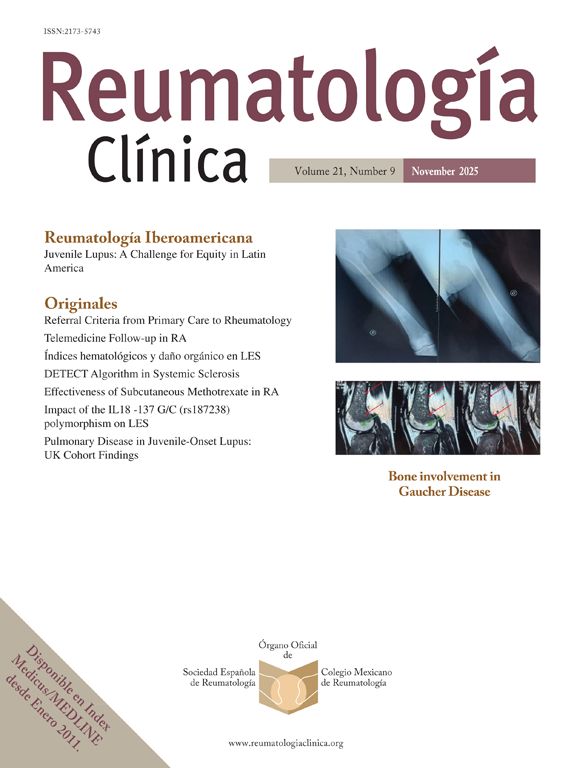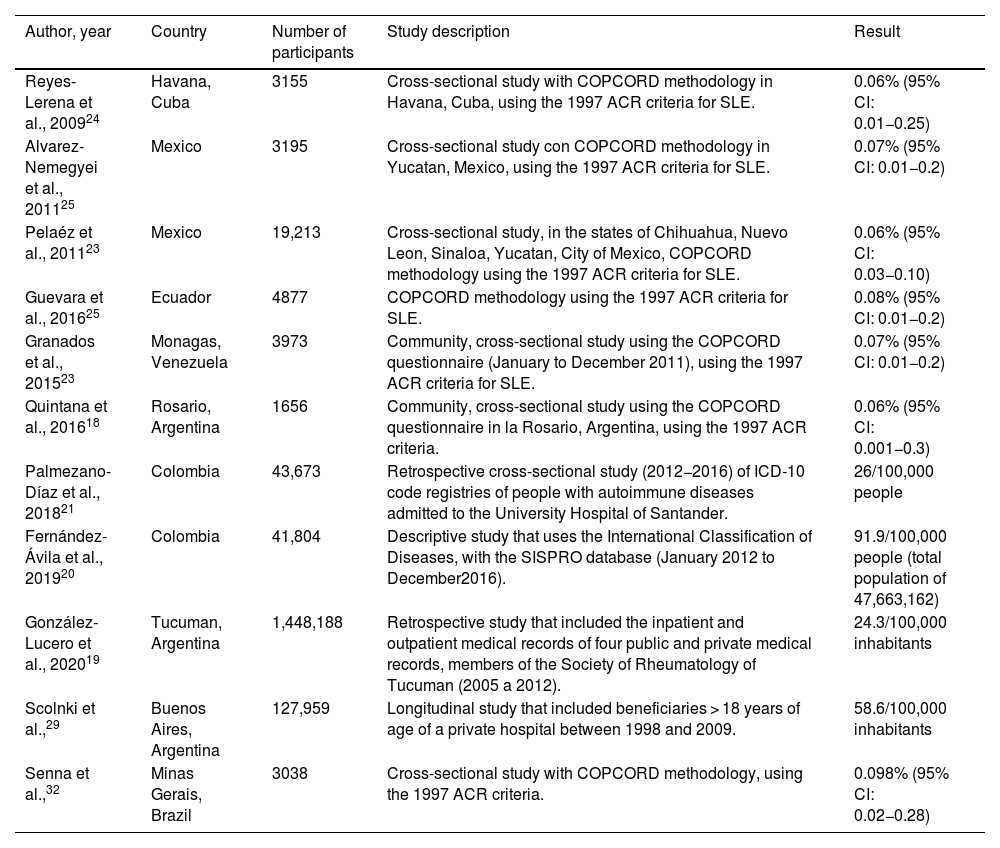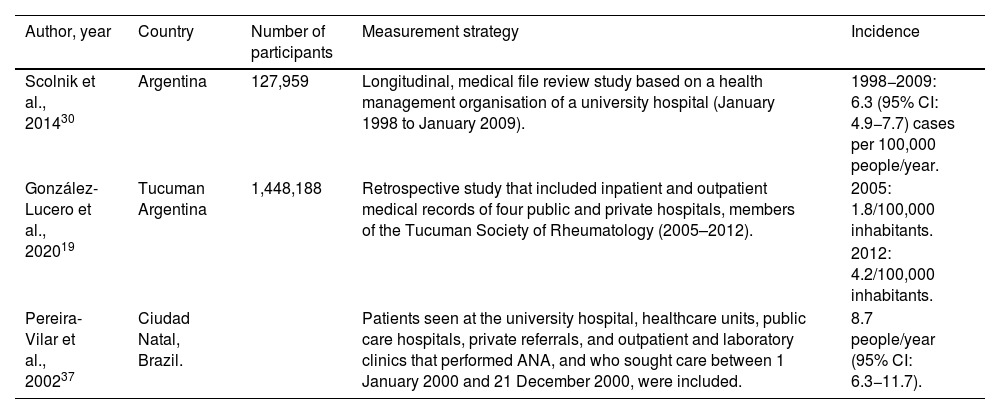Systemic lupus erythematosus (SLE) is a chronic autoimmune disease that affects several organs, causing significant morbidity and increased mortality. It’s more frequent in young, fertile women and can appear in all ethnic groups.
The worldwide prevalence report indicates that there are at least 5 million patients with SLE. Although this disease can be found in every geographic region, certain races are more affected, such as Afro-American, Hispanic, and Asian populations. Furthermore, most of the epidemiologic information comes from Europe or the USA. In Latin America, only a few countries have reported data, like Argentina, Colombia, or Mexico, and even in these countries, the numbers vary.
El lupus eritematoso sistémico (LES) es una enfermedad autoinmune crónica que produce daño a diferentes órganos y sistemas, lo que conlleva una morbilidad significativa y un aumento en el riesgo de muerte. Es más frecuente en mujeres en edad reproductiva.
A nivel mundial, el LES afecta aproximadamente a 5 millones de personas. Si bien puede presentarse en cualquier región geográfica, se ha demostrado que existe una mayor incidencia y prevalencia en afroamericanos, asiáticos e hispanos. Sin embargo, la información epidemiológica disponible sobre esta patología proviene mayormente de países europeos y asiáticos, así como de Estados Unidos de América (EE. UU.). En Latinoamérica (LATAM), pocos países cuentan con estudios descriptivos, como Argentina, Colombia y México los cuales reportan diferentes incidencias y prevalencias, probablemente asociadas a diferencias étnicas y reportes.
Esta revisión tiene como finalidad resumir la información epidemiológica actual sobre el LES en Latinoamérica.
Systemic lupus erythematosus (SLE) is a chronic autoimmune disease that is clinically and serologically heterogeneous.1 Its pathophysiology involves a genetic predisposition and environmental factors that impair the innate and adaptive immune response, leading to tissue damage and increased morbidity and mortality.2 Treatment goals are to modulate the immune system to achieve a state of low activity or remission of the disease.3 This has led to increased survival in the short and medium term; however, over the long term, damage can accumulate in different organs, which increases mortality. At present, overall 5-, 10-, and 15-year survival is reported to be 95, 91, and 85%, respectively.4
Despite its worldwide distribution, SLE predominantly affects Afro-American, Asian, and Hispanic individuals, among whom its incidence, prevalence, severity, and mortality are highest according to European and North American studies.5,6
Given the paucity of epidemiological studies regarding the incidence, prevalence, and mortality of SLE conducted in Latin America (LATAM),7–9 this review seeks to summarise the evidence related to these reports.
Prevalence of systemic lupus erythematosusSLE is reported to afflict at least 5 million people worldwide.9 However, its prevalence varies across geographical areas and ethnicities.5
In Asia, its prevalence has been seen to differ. Taiwan has reported a prevalence rate of 8.11 (95% CI 7.53–8.74) and the relative risk in women has been estimated at 9.14 (95% CI 8.36–9.98). The age at the time of debut is 40–49 years, and 20–29 years in males.10 In contrast, South Korea reports a higher prevalence rate, specifically 35.45 (95% CI 34.93–35.96), with a peak incidence between the ages of 40 and 49 years.11 Studies in China also point toward a high prevalence rate of 37.56 (95% CI 34.17–40.96)12 and a prevalence of 37–70 cases per 100,000 people.13 In contrast, in northern India, its prevalence was found to be a mere 3.2 per 100,000 people, which is the lowest of all Asian countries; in fact, not a single case of SLE was found among adults in certain rural and urban areas of Jammu, India.7,14
Oceania has reported different prevalences depending on its demographic composition and ethnic differences. For example, Australia reports a prevalence of 92.8 cases per 100,000,15 while New Zealand has reported a prevalence of 42.1 cases per 100,000 according to national databases.16
In the Americas, the USA reports a prevalence of 72.8 per 100,000 individuals (95% CI: 65.3–81.0), with a ratio of nine females for every one male affected. As for racial difference, African Americans were found to have a prevalence of 230.9 per 100,000 inhabitants (95% CI: 178.2–299.2) followed by the Hispanic population for whom the prevalence was reported to be 120.7 per 100,000 people (95% CI: 84–173.4).17 Another study found a twofold higher prevalence among African American women compared to Caucasian women,18 286.37 per 100,000 people compared to 150.09 per 100,000 people,19 respectively.
Furthermore, the number of people diagnosed with SLE can vary significantly over time. In a Canadian population, the prevalence rate was documented to have increased from 48 cases per 100,000 people in 2000 to 90 cases per 100,000 individuals in 2015,20 while in the USA, Li et al. documented that the prevalence rate of SLE in seniors over 65 years of age rose consistently from 184 cases per 100,000 people in 2009 to 239 cases per 100,000 inhabitants in 2016.21
There are only a limited number of studies in LATAM and in several countries, the COPCORD methodology has been used to report prevalence rates of some rheumatological diseases, including SLE, taking into account the limitations inherent in the use of this methodology.
In Mexico, in the southern region of the country, in the state of Yucatan, where only 40.5% of the population lives in urban areas and from a sample of 3195 individuals, Alvarez et al. conducted a study and found a prevalence of 0.07% (95% CI: 0.01−0.2).22 Another study carried out by Pelaez et al. in five states of Mexico and that included 19,213 participants reported a prevalence rate of 0.06% (95% CI 0.03−0.10).23
Meanwhile, in Cuba, Reyes et al. evaluated 3155 individuals following the COPCORD methodology and reported a 0.06% (95% CI: 0.01−0.2)24 prevalence rate of SLE, whereas in Ecuador, Guevara et al. included 4877 individuals using the same methodology and documented a prevalence rate of 0.08% (95% CI: 0.01−0.2); there were no cases reported in rural areas.25
In a community study using the same methodology in the northeastern region of Venezuela, Granados et al. included 3973 subjects and quantified the prevalence rate of SLE to be 0.07% (95% CI: 0.01−0.02).26
In contrast, in Colombia, a health registry revealed a 91.9 per 100,000 persons prevalence rate of SLE; the age-adjusted prevalence was 126.3 per 100,000 individuals in the population over the age of 18 years.27 That being said, Palmezano-Díaz et al. reported a markedly lower prevalence of 26 per 100,000 among patients seen at the Santander University Hospital in Colombia.28
As for Argentina, Scolnik et al. observed a prevalence rate of 58.6 cases per 100,000 inhabitants (95% CI: 46.1–73.5), based on the population of a hospital in Buenos Aires, in which 127,959 users were analysed. It should also be noted that women presented a peak prevalence in the fifth decade of life with 142.2 per 100,000 individuals, whereas the peak prevalence rate among men was observed to occur in the fourth decade of life with 41.9 per 100,000 people.29 By contrast, Quintana et al. included 1656 individuals in a Qom indigenous populations and found the prevalence rate of SLE to be 0.06% (95% CI: O.001−0.3),30 while another study that was performed in Tuchman in northeastern Argentina reported a prevalence rate of 24.3 cases/100,000 inhabitants (95% CI: 22.6–28.8); the age-adjusted prevalence rate was 34.9 cases per 100,000 people (95% CI: 32.8–41).31
In a study that was carried out in a region in northern Brazil that included 3.038 patients following the COPCORD methodology, Senna et al. reported a prevalence of 0.098% (95% CI: 0.02−0.28).32
Table 1 and Fig. 1 illustrate a summary of the studies that have examined the prevalence of SLE in LATAM.
Prevalence of SLE in Latin America.
| Author, year | Country | Number of participants | Study description | Result |
|---|---|---|---|---|
| Reyes-Lerena et al., 200924 | Havana, Cuba | 3155 | Cross-sectional study with COPCORD methodology in Havana, Cuba, using the 1997 ACR criteria for SLE. | 0.06% (95% CI: 0.01−0.25) |
| Alvarez-Nemegyei et al., 201125 | Mexico | 3195 | Cross-sectional study con COPCORD methodology in Yucatan, Mexico, using the 1997 ACR criteria for SLE. | 0.07% (95% CI: 0.01−0.2) |
| Pelaéz et al., 201123 | Mexico | 19,213 | Cross-sectional study, in the states of Chihuahua, Nuevo Leon, Sinaloa, Yucatan, City of Mexico, COPCORD methodology using the 1997 ACR criteria for SLE. | 0.06% (95% CI: 0.03−0.10) |
| Guevara et al., 201625 | Ecuador | 4877 | COPCORD methodology using the 1997 ACR criteria for SLE. | 0.08% (95% CI: 0.01−0.2) |
| Granados et al., 201523 | Monagas, Venezuela | 3973 | Community, cross-sectional study using the COPCORD questionnaire (January to December 2011), using the 1997 ACR criteria for SLE. | 0.07% (95% CI: 0.01−0.2) |
| Quintana et al., 201618 | Rosario, Argentina | 1656 | Community, cross-sectional study using the COPCORD questionnaire in la Rosario, Argentina, using the 1997 ACR criteria. | 0.06% (95% CI: 0.001−0.3) |
| Palmezano-Díaz et al., 201821 | Colombia | 43,673 | Retrospective cross-sectional study (2012−2016) of ICD-10 code registries of people with autoimmune diseases admitted to the University Hospital of Santander. | 26/100,000 people |
| Fernández-Ávila et al., 201920 | Colombia | 41,804 | Descriptive study that uses the International Classification of Diseases, with the SISPRO database (January 2012 to December2016). | 91.9/100,000 people (total population of 47,663,162) |
| González-Lucero et al., 202019 | Tucuman, Argentina | 1,448,188 | Retrospective study that included the inpatient and outpatient medical records of four public and private medical records, members of the Society of Rheumatology of Tucuman (2005 a 2012). | 24.3/100,000 inhabitants |
| Scolnki et al.,29 | Buenos Aires, Argentina | 127,959 | Longitudinal study that included beneficiaries > 18 years of age of a private hospital between 1998 and 2009. | 58.6/100,000 inhabitants |
| Senna et al.,32 | Minas Gerais, Brazil | 3038 | Cross-sectional study with COPCORD methodology, using the 1997 ACR criteria. | 0.098% (95% CI: 0.02−0.28) |
ACR: American College of Rheumatology; ICD-10: International Classification of Diseases; COPCORD: Community Oriented Program for Control of Rheumatic Diseases; CI: confidence interval; SLE: systemic lupus erythematosus; SISPRO: Integrated Social Protection Information System.
The incidence of SLE exhibits pronounced variability around the world with the highest rate reported in the USA at 23.2 per 100,000 person-years and the lowest incidence rate observed in Africa and the Ukraine at 0.3 per 100,000 person-years.19,33,34
As with prevalence, the incidence of SLE is impacted by both geographic and ethnic factors. A 2018 study based on the SLE Epidemiologic Surveillance Registry in Michigan, USA, revealed a significantly higher age-adjusted incidence rate among Arab and Chaldean Americans (7.6 per 100,000 individuals) in comparison to the Caucasian population (3.7; 95% CI: 3.1–4.2; p = 0.02).35 These findings are consistent with those of a study performed in the United Arab Emirates, which documented an age-standardised incidence rate of 8.6 cases per 100,000 individuals/year over a 4-year period.34
An update of the data concerning the incidence of SLE in the US Medicare population was conducted in 2020, and overall incidence rates adjusted for age and sex were calculated for the cohorts from 2009 to 2016. Compared to the general population, the incidence was greater in women (OR: 1.4) and blacks (OR: 1.3–1.6); the overall age- and sex-adjusted incidence of SLE was approximately 30 per 100,000 persons for all ages and 40 per 100,000 persons aged 65 years and older.21
A meta-analysis based on national SLE registries in the USA yielded an overall incidence rate of 5.1 per 100,000 person-years (95% CI: 4.6–5.6). Nevertheless, significant disparities were observed when broken down by both sex and race. The incidence rate in females was as much as seven times greater than in males. With regard to racial differences, Hispanic patients had an incidence rate of 6.8 per 100,000 females/year (95% CI: 6-2-7.6), while in Hispanic males the incidence was 0.9 per 100,000 men/year (95% CI: 0.4–1.9).36
Of the studies carried out in LATAM, the ones performed in Argentina are particularly noteworthy. Between 1998 and 2009, in a private system in Buenos Aires that serves 5%–7% of the population (predominantly Caucasian), the overall incidence was estimated to be 6.3 (95% CI: 4.9−7.7) cases per 100,000 person-years (95% CI: 4.9−7.7) and displayed a clear gender difference; i.e., while the incidence rate was 8.9 per 100,000 person-years (95% CI: 8.9 per 100,000 person-years) among women, peaking in the third decade of life, for men, the incidence rate was 2.6 per 100,000 person-years (95% CI: 1.2–3.9).29 Another study was carried out in the state of Tucuman, Argentina and reported an incidence of 1.8 cases per 100,000 person-years in 2005 (95% CI: 1–2.9), increasing to 4.2 cases per 100,000 person-years in 2012 (95% CI: 2.9–5.8).31
Regional variations within countries are also worth noting. In northwestern Brazil, Pereira et al. reported an incidence of 8.7 per person-years (95% CI 6.3−11.7), with a marked gender difference: 14.1 per 100,000 females/year and 2.2 per 100,000 males/year.37
Table 2 presents a summary of the studies that have been performed looking at the incidence of SLE.
Studies regarding the incidence of SLE in Latin America.
| Author, year | Country | Number of participants | Measurement strategy | Incidence |
|---|---|---|---|---|
| Scolnik et al., 201430 | Argentina | 127,959 | Longitudinal, medical file review study based on a health management organisation of a university hospital (January 1998 to January 2009). | 1998−2009: 6.3 (95% CI: 4.9−7.7) cases per 100,000 people/year. |
| González-Lucero et al., 202019 | Tucuman Argentina | 1,448,188 | Retrospective study that included inpatient and outpatient medical records of four public and private hospitals, members of the Tucuman Society of Rheumatology (2005–2012). | 2005: 1.8/100,000 inhabitants. |
| 2012: 4.2/100,000 inhabitants. | ||||
| Pereira-Vilar et al., 200237 | Ciudad Natal, Brazil. | Patients seen at the university hospital, healthcare units, public care hospitals, private referrals, and outpatient and laboratory clinics that performed ANA, and who sought care between 1 January 2000 and 21 December 2000, were included. | 8.7 people/year (95% CI: 6.3−11.7). |
ANA: antinuclear antibodies; CI: confidence interval; SLE: systemic lupus erythematosus.
SLE mortality is affected by genetic factors, age, disease severity, and co-morbidities.38 In the 1950s, the 5-year survival rate was a mere 50%, while in the 1990s it was reported to have increased to 90%. Even so, it is regarded as a disease that is associated with a high mortality rate. At present, some groups continue to have higher mortality rates, such as women (3.14 vs. 2.98 for men) and Blacks (3.34 vs. 2.43 for Caucasians; however, it is hoped that early diagnosis and effective therapies will significantly lower mortality rates. In the USA, Yen et al. reported that age-standardised mortality rate (ASMR) from SLE fell from 0.45 (95% CI: 0.42−0.48) per 100,000 individuals in 1968 to 0.34 (95% CI: 0.32−0.36) per 100,000 people in 2023, although the decrease was much more modest when compared to patients without SLE.39
In 2019, Scherlinger et al. estimated that 6418 SLE-related deaths had occurred in 84 countries in 2014, accounting for 0.021% of all deaths using the World Health Organization (WHO) mortality database and the International Classification of Diseases (ICD-10) code. The calculated overall ASMR was 2.68 (95% CI: 2.62–2.75) per million deaths with a significantly higher ASMR in females (4.53; 95% CI: 4.40–4.65) than in males (0.79; 95% CI: 0.73−0.84).
In the USA, the ASMR was lower (2.69; 95% CI: 2.53–2.84) than in LATAM (5.53; 95% CI: 5.33–5.73).38 Another US study (2007 and 2009) that included 812 SLE patients reported a total of 135 deaths (16.6%). African-American patients had a 1.5 relative risk (RR) of death (95% CI: 1.1–2.3) and died 6.8 years earlier than Caucasian patients. Similar results were noted for Hispanic patients with a RR of 1.1 (95% CI: 0.7–1.8); likewise, they died 9.5 years earlier than non-Hispanics (P = .02). Standardised mortality rates are 4-fold higher among African-American and Hispanic individuals compared to Caucasians without SLE. The ASMR for the Hispanic population was 3.9 and was greater for Hispanic females, for whom the ASMR was 5.8.40
In 2017, Anastasiou et al. evaluated mortality trends in hospitalised patients with SLE in the US. They identified close to two million people who were discharged between 2006 and 2016 and found that mortality rates declined from 2006 to 2008 and then remained relatively stable thereafter. African-American, Hispanic, Asian, and Pacific Islander patients had a higher in-hospital mortality rate than Caucasian patients.41 Another study that examined 175,000 SLE-related hospitalisations in the USA reported that the leading causes of in-hospital death were infections (38.18%) followed by heart disease (12.04%),42 which is very much in line with the findings from the National Center for Health Statistics data in the USA where the leading causes of in-hospital death were sepsis (4.3%) and systemic arterial hypertension (3.0%) in women, while in men, the main causes of in-hospital demise were heart disease (3.7%) and complications related to diabetes mellitus (3.6%).43
In LATAM, high-risk groups and the most common causes of death in SLE populations have been reported. In Argentina, 32 deaths were reported among 353 SLE patients attending public hospitals and private rheumatology clinics between 2005 and 2012, with an overall 9.1% (95% CI: 6.3–12.6) mortality rate within the SLE cohort.31
In Brazil, a study using data from the Brazilian National Health System revealed a 3.8 (95% CI: 3.78–4.03) per 1,000,000 inhabitants annual age-adjusted mortality rate due to SLE between the years 2002 and 2011.44 Another study by Costi et al., reported a mortality rate of 4.76 per 1,000,000 individuals, with geographic differences inasmuch as the Midwest, North, and Southeast regions had the greatest mortality (6.4, 5.4 and 5.23 per 1,000,000 inhabitants, respectively). Based on 8761 death certificates of SLE patients, 77% of the deaths were attributed to SLE as the primary cause, whereas 6% were reported to be due to circulatory causes, 2.8% to infectious and parasitic causes, and 2.2% cited respiratory issues as the primary cause of death.45
In Mexico, SLE ranks among the top 20 causes of death among females aged 10–54 years, occupying a disturbing 19th place in the 10–14 age group and 15th among 15–24 years old.46
A study by Mendoza-Pinto et al. using an open national database revealed that between 1998 and 2017, there were 11,449 reported SLE deaths in patients over the age of 15 years; of them, 75% of the deaths occurred in patients under the age of 50 years, and 3.8% of the deaths were in geographic areas with a predominantly indigenous population. Furthermore, the authors reported a significant increase in ASMR between 1998 and 2017. ASMR rose from 0.40 per 100,000 persons (95% CI 0.26−0.57) to 0.89 per 100,000 persons (95% CI 0.72–1.05), which represents an 81% increase. This contrasts with the 86% decrease observed in the non-SLE population during the same period.8
Table 3 provides a summary of the studies that report SLE mortality in LATAM.
Mortality from SLE in Latin America.
| Author, year | Country | Measurement strategy | Mortality |
|---|---|---|---|
| Souza et al., 201036 | Sao Paulo, Brazil | The official database was used, in which SLE was stated as the underlying cause of death (1985−2004). | 3.8 deaths/105 deaths. |
| Ribeiro-Costi et al., 201737 | Brazil | Exploratory study using data from the DATASUS Mortality Information System (from 2000 to 2011). | 4.76 deaths/105 deaths. |
| González-Lucero et al., 201919 | Tucuman, Argentina | Retrospective study including inpatient and outpatient medical records from four public and private hospitals, members of the Rheumatology Society of Tucuman (2005 to 2012). | 9.1% |
| Mendoza-Pinto et al., 202240 | Mexico | Data from the DGIS were studied; the ICD-10 was used to define the cause of death from SLE (1998 to 2017). | 11,449 deaths from SLE were identified. |
ICD-10: International Classification of Diseases; DATASUS: Department of Computing of the Unified Healthcare System; DGIS: Directorate General for Health Information; SLE: systemic lupus erythematosus; NIS: National Inpatient Sample.
While the reported prevalence of SLE worldwide ranges from 8.1 to 92.8 per 100,000 individuals,10,15 it is important to be aware that there are substantial ethnic and geographic differences.
LATAM has a limited number of studies that include countries such as Colombia,27,28 Argentina,30,31 Mexico,22,46 Venezuela,26 and Cuba,24 and although most of these studies investigated the population of specific locations within these countries, the prevalence varied little, ranging from 0.06% to 0.09%.23,30,32 That being said, we must not overlook the fact that the prevalence rates are dynamic and vary within the same geographical regions. As far as incidence is concerned, it is even more complicated to report. The studies available found incidence rates ranging from 0.03 up to 23.2 per 10,000 individuals/year around the world,29,31,33,34 and that the incidence of SLE was found to be greater among women and African Americans,21 while in LATAN, the incidence varies between 6.3 and 8.7 per 100,000 inhabitants/year,29,37 with women being the hardest hit in terms of incidence, although the age of debut was younger among men, similar to findings in other countries.21,29,37
Despite the fact that mortality has decreased in the general population worldwide, this trend has not been evident in patients with SLE. In fact, most studies report an increase in mortality.47 This troubling discrepancy may be attributed to disparities in access to healthcare services and the high costs of medical care.
In Mexico, SLE has been identified as one of the twenty main causes of death in young women.46 This could be extrapolated to other Latin American countries, highlighting the relevance of this disease for public health. These data are crucial to be considered when designing health policies directed at this age group.
The inherent limitations of this study must necessarily be acknowledged. The poor population representativeness, owing to the small number of studies concerning prevalence, incidence, and mortality, together with the heterogeneity of the data, pose challenges when it comes to the generalisability of the findings. Moreover, the possibility of bias is also relevant, considering that many studies are based on rural populations or on data extracted from registries and census data, which in turn can have an impact on the accuracy of the estimates.
ConclusionRegardless of being a relatively infrequent disease at a global level, SLE has a considerable impact on health care systems. In LATAM, the scarcity of epidemiological studies hampers improvement of patient care and optimisation of public health programmes. Promoting research in this region is essential to better understand the epidemiology of SLE and thus, be able to develop more effective strategies for its prevention, diagnosis, and treatment.
FundingThis research has not received any specific support from public sector agencies, the commercial sector, or non-profit organisations.
The authors have no conflict of interests to declare.










